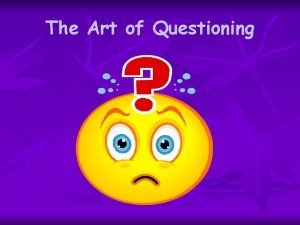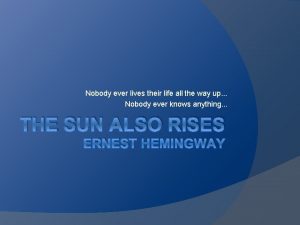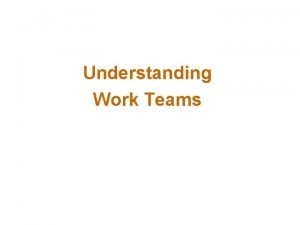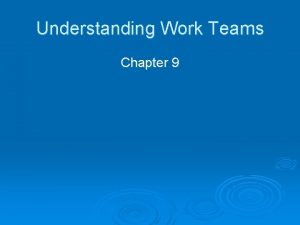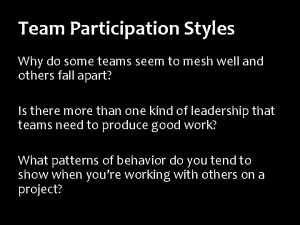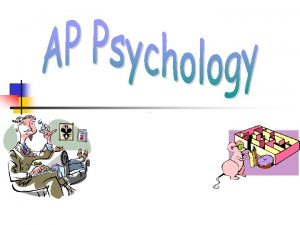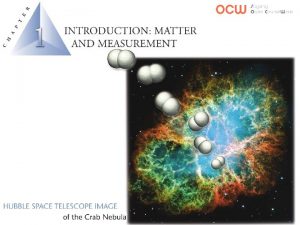WHY Ever wondered why some teams just seem



















- Slides: 19

WHY ? ? Ever wondered why some teams just seem to work and others hit the rocks? When things don’t work, it has a great impact on the people involved, as well as the project or objective to be achieved. In 1970’s Dr. Meredith Belbin set out observing teams. The research revealed that the difference between success and failure for a team was not dependent on factors such as intellect…. but more on behaviour.

THE TEAM ROLES By Dr. Meredith. Belbin

WHAT IS TEAM ROLE ? Tendency to behave, contribute and interrelate with others in a particular way.

WHY WE NEED TO STUDY TEAM ROLES Provide a common language to talk about how people behave in the work place.

THE 9 TEAM ROLES 1) 2) 3) 4) 5) 6) 7) 8) 9) Plant Monitor Evaluator Co-ordinator Resource Investigator Implementers Complete Finisher Teamworker Shaper Specialist

1. PLANT one such individual was “planted” in each team – the Innovator, turning out loads of radical ideas. highly creative and good at solving problems in unconventional ways -unorthodox

2. MONITOR EVALUATOR provide a logical eye, make impartial judgements where required -analytical weigh up the team’s options in a dispassionate way - objective

3. CO-ORDINATORS focus on the team’s objectives and draw out team members Calm, self confident and decisive when necessary. The social leader of the group, ensuring individuals contribute fully and guiding the team to success

4. RESOURCE INVESTIGATORS The extrovert, enthusiastic communicator, with good connections outside the teams. Enjoys exploring new ideas, responds well to challenges, and creates this attitude amongst others.

5. IMPLEMENTERS to plan a practical, workable strategy – disciplined and reliable carry it out as efficiently as possible.

6. COMPLETER FINISHERS most effectively used at the end of a task, to “polish” and scrutinise the work for errors, subjecting it to the highest standards of quality control – perfectionist and accurate

7. TEAMWORKERS helped the team to gel, using their versatility to identify the work required and complete it on behalf of the team.

8. SHAPERS Energetic, highly strung, with a drive to get things done provide the necessary drive to ensure that the team kept moving and did not lose focus or momentum.

9. SPECIALISTS individual with in-depth knowledge of a key area – single minded, self reliant and knowledgeable

TEAM ROLE STRENGTHS WEAKNESSES Plant Creative, imaginative, original, offers alternative approaches Pre-occupied by thoughts and may not be communicative Monitor Evaluator Logical, analytical, Appears slow moving, lacks discerning, makes drive and may appear decision based on facts uninspiring Co-ordinator Calm, confident, clarifies goals, promotes joint decision making Can be seen as manipulative, off-loads personal work Resource Investigators Enthusiastic, communicative, explores opportunities, develops contracts Over-optimistic, easily bored and can lose interest

TEAM ROLE STRENGTHS WEAKNESSES Implementers Disciplined, organised, efficient, turns idea into actions Somewhat inflexible, slow to embrace change or accept new ideas Complete Finishers Accurate, conscientious, meticulous perfectionist Inclined to worry unduly, reluctant to delegate Teamworkers Cooperative, caring, Maybe indecisive when diplomatic, sensitive, averts faced with tough friction decisions Shapers Challenging, dynamic, goal Prone to provocation and -oriented, has drive and can be blunt and upset courage people Specialist Single-minded, motivated Contributes on a narrow by the pursuit of knowledge front, dwells on technicalities

BALANCE IS KEY Each of the behaviours were essential in getting the team successfully from start to finish. For example a team with no Plant struggled to come up with the initial spark of an idea with which to push forward. However, with too many Plants bad ideas will concealed good ones and non-starters were given too much airtime. Similarly, with no Shaper, the team ambled along without drive and direction, missing deadlines With too many Shapers, in-fighting began and morale was lowered.

CONCLUSION Role identification can be used as a form of team building : it reinforces the fact that everyone is bringing something to the team, so you all need each other if you are to be successful. The brief descriptions were of “pure” roles that you’re unlikely to find in practice : what you saw depends on the mix of preferred roles in each individual. Although your preferred roles are relatively unchanging over time, most of us can perform two or three roles – which is important if you have a team of less than 9 people.

TEAM ROLE PREFERENCES By completing a Belbin-Self Perception Inventory
 Have you ever wondered why some people
Have you ever wondered why some people Have you ever wondered
Have you ever wondered Art of questioning
Art of questioning Ever ancient ever new
Ever ancient ever new Ever ancient ever new
Ever ancient ever new Ever ancient ever new
Ever ancient ever new Ever tried ever failed no matter
Ever tried ever failed no matter Already never ever yet
Already never ever yet Who is the poet of the poem the naughty boy
Who is the poet of the poem the naughty boy For many years people have wondered
For many years people have wondered How many scenes are in act 5 of romeo and juliet
How many scenes are in act 5 of romeo and juliet Hey hey bye bye
Hey hey bye bye Everyone is a reader some just haven't
Everyone is a reader some just haven't Why have teams become so popular
Why have teams become so popular Understanding teams
Understanding teams They say it only takes a little faith to move a mountain
They say it only takes a little faith to move a mountain Sometimes you win some sometimes you lose some
Sometimes you win some sometimes you lose some Is cake countable or uncountable
Is cake countable or uncountable Contact forces
Contact forces Some say the world will end in fire some say in ice
Some say the world will end in fire some say in ice


